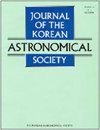大型SDSS类星体群及其统计意义
IF 0.8
4区 物理与天体物理
Q3 ASTRONOMY & ASTROPHYSICS
引用次数: 15
摘要
我们使用斯隆数字巡天(SDSS) DR7类星体目录中体积有限的类星体样本来识别类星体群并解决它们的统计显著性。这个类星体样本在天空中具有均匀的选择函数,并且可以从DR7星表中提取出几乎最大可能的连续体积。类星体群的识别采用一组固定的共移动连接长度的Friend-of-Friend算法。我们发现,当类星体群的连接长度为70h ?1Mpc时,最丰富的100个类星体群的丰富度分布或最大的100个类星体群的大小分布与具有相同数量密度和天空覆盖率的随机分布点的丰富度分布在统计上是相等的。研究表明,即使类星体没有物理聚类,cloes et al.(2013)报道的大型类星体群(Large Quasar Group, U1.27)这样的大尺度结构也能以高概率被发现,并且不会挑战最初的均匀宇宙学模型。我们的结果在统计上比Nadathur(2013)的结果更可靠,后者只对最大的类星体群进行了测试。结果表明,键长应小于50h ?为了使DR7星表中确定的类星体群不被偶然组合的类星体群所支配。我们提出了20个最丰富的类星体群,它们的连接长度为70 h?1Mpc以作进一步分析。本文章由计算机程序翻译,如有差异,请以英文原文为准。
LARGE SDSS QUASAR GROUPS AND THEIR STATISTICAL SIGNIFICANCE
We use a volume-limited sample of quasars in the Sloan Digital Sky Survey (SDSS) DR7 quasar catalog to identify quasar groups and address their statistical significance. This quasar sample has a uniform selection function on the sky and nearly a maximum possible contiguous volume that can be drawn from the DR7 catalog. Quasar groups are identified by using the Friend-of-Friend algorithm with a set of fixed comoving linking lengths. We find that the richness distribution of the richest 100 quasar groups or the size distribution of the largest 100 groups are statistically equivalent with those of randomly-distributed points with the same number density and sky coverage when groups are identified with the linking length of 70 h?1Mpc. It is shown that the large-scale structures like the huge Large Quasar Group (U1.27) reported by Clowes et al. (2013) can be found with high probability even if quasars have no physical clustering, and does not challenge the initially homogeneous cosmological models. Our results are statistically more reliable than those of Nadathur (2013), where the test was made only for the largest quasar group. It is shown that the linking length should be smaller than 50 h?1Mpc in order for the quasar groups identified in the DR7 catalog not to be dominated by associations of quasars grouped by chance. We present 20 richest quasar groups identified with the linking length of 70 h?1Mpc for further analyses.
求助全文
通过发布文献求助,成功后即可免费获取论文全文。
去求助
来源期刊

Journal of the Korean Astronomical Society
地学天文-天文与天体物理
CiteScore
1.30
自引率
10.00%
发文量
0
审稿时长
>12 weeks
期刊介绍:
JKAS is an international scientific journal publishing papers in all fields of astronomy and astrophysics. All manuscripts are subject to the scrutiny of referees. Manuscripts submitted to JKAS must comply with the ethics policy of JKAS. Six regular issues are published each year on February 28, April 30, June 30, August 31, October 31, and December 31. One year''s issues compose one volume.
 求助内容:
求助内容: 应助结果提醒方式:
应助结果提醒方式:


